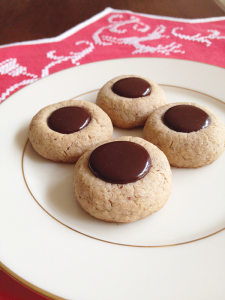 Is flour good for you? Now that the holidays are here — a time deliciously devoted to baking and consuming products made of flour — we wanted to shine a light on this popular grain.
Is flour good for you? Now that the holidays are here — a time deliciously devoted to baking and consuming products made of flour — we wanted to shine a light on this popular grain.
Let’s begin with our considerable consumption. According to some studies, the average American consumes between 400 to 500 cups of flour a year, which translates into about 1¼ cups (or 10 ounces) a day. “Six ounces of grains” is what the USDA recommends that we consume each day for all grains, not just flour, with an added recommendation that half of those 6 ounces be whole grains. So, 10 ounces from flour alone is both sobering and noteworthy.
Because, like many, I get a good dose of my daily grains from flour — from bread (two slices equal 2 ounces) to pasta (one cup equals 2 ounces) — I made a conscious decision years ago to stop eating foods made with refined white flour in favor of those made with the more nutritious whole wheat flour. It’s mostly what I bake with, too.
That’s not to say that white flour, which has been stripped of its bran and germ, has no merits. Much like whole wheat flour, a quarter cup of enriched white flour provides about 100 calories, 3 grams of protein and a slew of B vitamins and some minerals. Some enriched white flours, in fact, have more iron and certain B vitamins (such as folic acid) than their whole wheat cousins.
What refined white flour doesn’t have, however, is fiber — the nutrient that keeps us regular, helps with weight control, stabilizes blood sugars and assists with the removal of bad cholesterol. Most whole wheat flours provide about 3 grams of fiber per quarter cup.
Health-promoting phytochemicals and antioxidants such as vitamin E are also removed in the making of white flour. Studies have shown that both may help to protect against cancer, cardiovascular disease and Type 2 diabetes. Again, whole wheat flour boasts many of these beneficial compounds.
Lastly, many flour companies add benzoyl peroxide or chlorine dioxide to chemically whiten (bleach) their flours. Some add potassium bromate to chemically strengthen their flours. Several European countries, Canada and Japan have banned the use of these chemicals, but the US has not. Food in California that contains potassium bromate, however, must bear a warning label. Although the research is still out on the potential health risks of consuming these chemicals, numerous US flour companies no longer use them.
So, is wheat flour good for you? Yes; although some kinds are better than others. Whole wheat is more nutritious than white; enriched white is better than non-enriched white; and any flour that has not been bleached or bromated is better than the alternative.
Helpful tips
To prolong shelf life, transfer flour from its paper bag to an airtight plastic or glass container. Store refined flour in a cool, dry place. Store whole wheat flour in the fridge or freezer. Flour that has gone rancid smells sour. Bakers’ hints for baking with whole wheat flour: Make sure flour is fresh; add two teaspoons of liquid (water, milk, orange juice) per cup of whole wheat flour (to combat dryness); substitute some of the whole wheat flour in a recipe with all-purpose flour (for a lighter texture); and use “white whole wheat flour, “ which is simply whole grain flour that has been milled from white wheat (for a lighter color and milder taste).
Chocolate-Nut Thumbprints
Adapted from America’s Test Kitchen; Makes two dozen cookies
8 tablespoons (1 stick) unsalted butter, softened
½ cup sugar
¼ teaspoon salt
¼ teaspoon cinnamon
1 egg yolk
1 teaspoon vanilla extract
1 tablespoon milk
½ cup pecans, toasted and ground fine
1 cup white whole wheat flour*
¼ cup all-purpose flour
½ cup semisweet chocolate chips
¼ cup heavy cream or milk
1 tablespoon corn syrup
Heat oven to 350 degrees. Line baking sheets with parchment paper.
With electric mixer on medium speed, beat together butter, sugar, salt and cinnamon until smooth. Add yolk, vanilla, milk and nuts and beat until well blended.
With mixer on low speed, beat in flour just until dough forms a cohesive mass.
Roll dough into 1-inch-thick balls and place 1 inch apart on prepared sheets.
Bake for 10 minutes, remove from oven, and press indent into each cookie using thumb or bottom of rounded ½-teaspoon measure. Return to oven and bake 7 minutes more. Remove to a wire rack to cool.
In a small saucepan over medium-low heat, combine chocolate chips, cream or milk, and corn syrup, stirring constantly until smooth. Cool 20 minutes. Fill the thumbprints with the chocolate mixture; let sit for another 30 minutes.
*New to cooking with whole wheat flour? You may want to start with a ratio of ¾ cup whole wheat flour and ½ cup all-purpose flour for this recipe.
Anne Palumbo is a lifestyle columnist, food guru, and seasoned cook, who has perfected the art of preparing nutritious, calorie-conscious dishes. She is hungry for your questions and comments about SmartBites, so be in touch with Anne at avpalumbo@aol.com.

